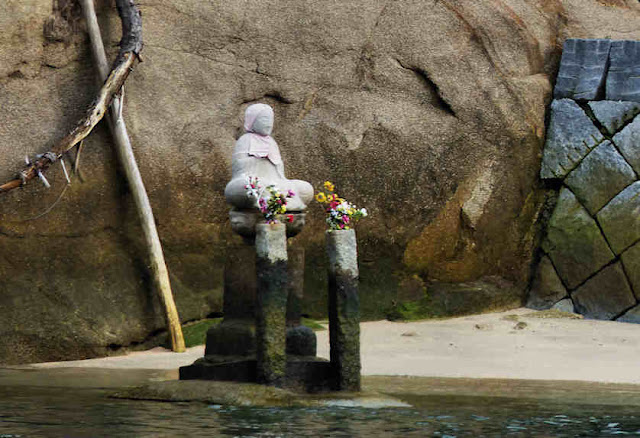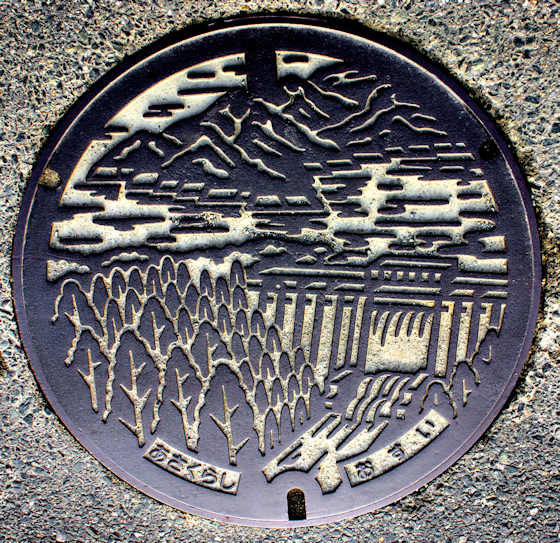Showing posts with label drainspotting. Show all posts
Showing posts with label drainspotting. Show all posts
Wednesday, July 16, 2025
To Mihara Castle Ruins
Labels:
castle,
chugoku33,
drainspotting,
ferry,
hiroshima,
ikuchijima,
manhole,
mihara
Thursday, November 23, 2023
Togitsu Town
The previous post in this series on day 64 of my first walk around Kyushu was the diary of day 63.
Labels:
drainspotting,
honjin,
kyushu108,
maneki neko,
manhole,
nagasaki
Friday, July 21, 2023
Decorative Manholes from Fukuoka, North Kyushu
Tagawa was a former coal-mining town whose two remaining brick chimneys are symbols of the town.
The previous post in the series was Saga Manholes.
Labels:
drainspotting,
kitakyushu,
kokura,
manhole,
okagaki,
pokemon,
tagawa
Wednesday, January 4, 2023
Saga Manholes
Saga Manholes
Obviously, from the design, Saga City used gas for streetlighting, probably in the early Meiji era.
Labels:
drainspotting,
kyushu108,
manhole,
saga,
yoshinogari
Wednesday, October 5, 2022
Manhole Art of the Chikugo Plain
January 4th, 2015, was the 55th day of my walk around Kyushu. I started from Amagi Station in Asakura, Fukuoka, and walked west across the Chikuzen Plain north of the Chikuzen River and ended at Tosu just inside Saga Prefecture. As with all my walks around Japan I kept my eyes open for manhole covers. These are eight I found that day. This first one depicts den-den daiko, a kind of drum. I cannot find any connection to Amagi.
I then crossed into Tosu City in Saga whose city flower is the Japanese Iris.
I have posted many times on Japan's unique manhole covers. Unfortunately many of the older posts no onger have photos, but more recent ones can be seen here. All the previous posts on my epic walk around Kyushu can be accessed by clicking the Kyushu108 tag below.
Labels:
drainspotting,
fukuoka,
kyushu108,
manhole
Monday, June 20, 2022
Recent Manhole Art
Yoshinogari is a huge archeological site with reconstructed buildings near Saga. Touted as the home of the legendary Himiko, "queen of japan", in all probability it wasn't.
However, all over Japan are appearing manhole covers featuring pokemon. There are hundreds of them, each one unique. This one is in Kaike Onsen, a seaside hot spring resort in western Tottori. I must admit I know nothing about pokemon except it is very popular. I believe these manholes are a feature of the pokemon go smartphone game
A few other posts with colorful designs can be found here....
if you would like to subscribe by email, just leave your email address in the comments below. It will not be published or made public. I post new content almost every day, and send out an email about twice a month with short descriptions and links to the most recent posts.
Labels:
azalea,
drainspotting,
falls,
Gotsu,
hiroshima,
manhole,
pokemon. kaike onsen,
saga,
tagawa,
yoshinogari
Friday, May 24, 2019
More Mascot Manholes
Though there was reputed to have been a culling of some of the more useless cute mascots that threaten to outnumber the humans in Japan, new one keep appearing and some make it onto manhole covers. These three were all found on my recent trips to Kyushu. This first one was in Omuta which is home to some of the coal mines that have become World Heritage sites.....
This one, found just outside Kumamoto Station celebrates the20th anniversary of Keroro, apparently a famous manga character, and the 70th anniversary of the introduction of theunderground drain and sewage system in Kumamoto.
This last one is thye town mascot for Kurino, a small town up in the mountains near Kirishima in Kagoshima.
Labels:
drainspotting,
manhole
Thursday, August 9, 2018
Mascot Manholes

There are more "cute" mascots per capita in Japan than anywhere else on the world by far. Last year a serious culling took place but still they continue to propagate. Among the latest is even one for the campaign to "promote" the cleanup of the nuclear meltdown at Fukushima.
To my mind such infantile mascots belong in the realm of the under 7's, but I seem to be in a minority. Its not surprising then that such mascots appear sometimes on the manhole and drain covers. The first is of one of the pair (male and female) of mascots for Sanda City in Hyogo. I believe it is based on the official city bird, the green pheasant.
The second depicts Ratochan, the official mascot of Oda City where Iwami Ginzan is located. It is based on the shell-candle miners used to take to light their work underground. The third is from Nakatsu. Kurokankun is based on Kuroda Kanbe, the samurai who built Nakatsu castle.
The fourth is Kintakun, the mascot of Kawanishi in Hyogo, and the final one is I think a cat in samurai helmet representing Hikone.
Subscribe to:
Comments (Atom)

































































